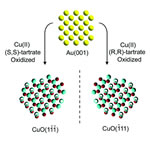Results of UMR chemist’s research on chiral surfaces featured in British journal Nature
Posted by news
Chemists at the University of Missouri-Rolla have developed a new process that could be used to sort biologically potent, useful chemicals from their less useful and sometimes toxic counterparts in a way that is less expensive and more widely applicable. Details of the process, which could improve the process for developing certain medicines, are published in the Oct. 2 issue of the British journal Nature.
 |
| UMR chemist Dr. Jay Switzer |
 |
| Microscopic image of chiral copper-oxide molecule deposited on a gold surface. |
With funding from the National Science Foundation’s (NSF) divisions of chemistry and materials research, Dr. Jay A. Switzer, the Donald L. Castleman/Foundation for Chemical Research Missouri Professor of Discovery in Chemistry at UMR, and colleagues have developed a process to separate or detect chiral molecules using electrodeposited chiral surfaces, rather than the current process that requires a homogeneous catalyst or an enzyme solution. This process has never been done before.
In the short term, Switzer’s research could simplify the production of such drugs as ibuprofen, Paxil and Nexium. In the long term, Switzer envisions the development of chiral sensors that could be implanted in the human body to monitor drug levels; or outside the body to detect chemical warfare agents.
"Throughout the biological world, in all living things, there are molecules which have a right- and a left-hand form," Switzer says. The two forms are like a person’s right and left hands almost identical, only reversed. "They are mirror images, but they aren’t superimposable," Switzer explains. "That is what we mean by chiral."
In the process of synthesizing molecules by normal chemical reactions, both the right- and left-hand forms of the molecules tend to be produced. But just as humans have a right- or left-handed preference, one form of the molecule tends to be very active and the other tends to be at best not very active; at worst, toxic.
One example of this is the drug thalidomide, originally used as a sedative. In the 1950s in Europe, thalidomide was prescribed to pregnant women to aid morning sickness. However, while one "hand" of the molecule relieved the woman’s nausea, the other hand was toxic, and caused birth defects.
Another common pharmaceutical example of chirality is the drug ibuprofen, commonly found in over-the-counter pain relievers. In its case, the molecule’s left hand is 100 times more powerful than the right. Switzer estimates that approximately one third of all drugs are chiral, including such familiar brands as Lipitor, Zocor, Paxil, Zoloft and Nexium each of which yield sales of more than $1 billion a year.
Currently, most chiral pharmaceuticals are made using an enzyme solution or homogeneous catalyst to produce the desired form. "The problem with this method is that the catalyst you add to the solution to make the correct form then has to be separated from the product. You’d like to have a solid, or heterogeneous, catalyst," Switzer says.
Switzer’s team of researchers has developed a chiral surface that could be used as this type of catalyst.
To create the new catalyst, Switzer immersed a thin layer of gold in a liquid containing copper and a handed chemical called tartrate, while applying an electric current to the system. (Tartrate is the salt formed from neutralizing tartaric acid a chemical derived from grapes that is often observed as a white deposit on the bottom of wine corks.) The electricity caused copper-oxide to bond to the gold in a technique very similar to the electroplating process used to produce the chrome used on automobiles.
"We’ve made a material where the entire product is chiral, not just the surface," Switzer says. "In earlier experiments, you would modify a surface with a chiral modifying agent, and if the agent washes off, the surface is no longer effective. In our research, the film itself is chiral, so the effectiveness remains even after many chemical reactions."
Initial tests have shown that the material can differentiate the hands of chiral tartrate without breaking down or being permanently altered. Pending tests will determine if this technique can produce similar results with amino acids and sugars, such as glucose.
"One of the things we’re thinking of is an implantable chiral sensor," Switzer says. "Many drugs, including thalidomide, switch hands in the body. The implantable sensor could be used to monitor the levels of such chiral drugs in the body." Another such chemical is glucose. An implantable chiral sensor would allow diabetics to monitor their blood sugar levels.
In addition to its numerous pharmaceutical uses, Switzer hopes similar catalysts can be developed to create sensors for chemical warfare agents.
Working with Switzer on the chiral surfaces research are Hiten M. Kothari, a graduate student who received a master’s degree in chemical engineering from UMR in 2002; Dr. Philippe Poizot, a former post-doctoral fellow at UMR; Dr. Shuji Nakanishi, a post-doctoral fellow from Osaka University; and Dr. Eric W. Bohannan, an X-ray diffraction specialist at UMR’s Graduate Center for Materials Research. Bohannan received a Ph.D. in chemistry at UMR, where he first worked with Switzer.